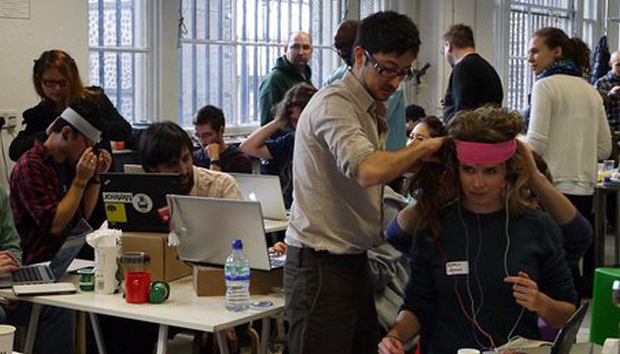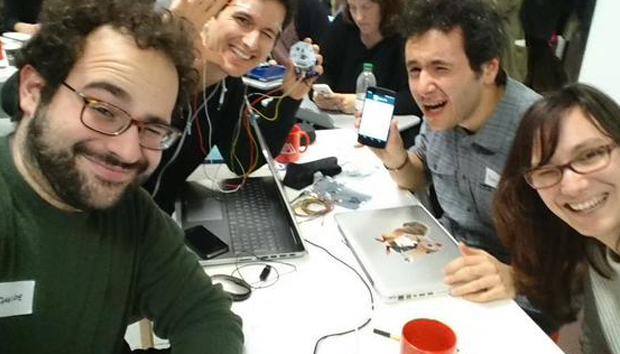The big screen displays the shared interface of a smartphone MP3 player. Sitting to the right, a man is hooked up to a simple EEG headset. After a pause, he winks with his left eye. The music begins to play. He winks with his right eye… and the track changes. It is a small but impressive display. And the audience love it.
“We wanted to control a smartphone via brainwaves,” explains Davide Valeriani, spokesperson for this team during the first UK brain hackathon, Hack the Brain, hosted in London this weekend. The original idea was to create an Android app that would connect Open BCI via Bluetooth called “Okay brain” the problem was it didn’t work, “so we named it Wink it”.
Organised by Imre Bard, a PhD student at the London School of Economics and Political Science (LSE) and Research Officer on the EU-wide NERRI Project, this challenge gave teams from 9am on Saturday to 5pm on Sunday to devise and develop an idea, then present it to a panel of expert judges. This is the latest example of an explosion of interest in this type of tech which includedBrainTech 2015 in Israel hosted earlier this month.
“The benefit of a hackathon is you can take a blue sky project and test it out at the weekend,” as one contestant puts it. In fact, much of the technology is so new, and its potential so untested, that a lot of this is simply proof of concept.

Image credit: Rain Rabbit via Flickr
It takes place at the Makerversity, a strange labyrinth of concrete tunnels deep in the bowels ofSomerset House. The furniture is funky and the most desirable consumer kit, like Muse and Oculus Rift,can be found strewn amongst a bizarre assortment of wires, sensors and DIY paraphernalia. One bloke has two bits of wire up his nose with red glowing lights underneath. Another boasts a thin band with a couple of engineering-style chips slap-bang in the centre of his forehead.
Like any experimental event, the final presentations vary a lot in execution and clarity. This is little wonder: to produce a decent solution in this short space of time is a pretty mean feat; to present it cogently is even harder.
“Wink it” emerges as the overall winner of the Science Museum Prize winner and is awarded £250 of development money and an invitation to the inaugural event of Science Museum’s ‘You Have Been Upgraded’ Festival. This was a simple, well-delivered solution that has the potential for something far greater.

“The idea should be bigger than winking,” says Valeriani as the judging panel quizzes him about the left-behind individuals who struggle to wink with each eye separately. This was all his team could achieve in such a short time frame. Yet it is clear that direct mental engagement with our mobile phones could change communication. To put it bluntly: tech which is ‘telepathic’ is surely more important than tech which is simply wearable?
The two runners up also present clear usable ideas with extensive potential futures. Emography, which won a Myndplay bundle, along with an invitation to present at the Science Museum event showcases “emotional cartography”. As Ben Styles, spokesperson for the team explains, this is a geographical map of emotion displayed in real-time on Google maps.
Beyond “curiosity” he sees the benefits ranging from understanding where a baby doesn’t want to be, through to building a database of emotional information. The latter could provide new insight into something as pragmatic as traffic. It also reminded me strongly of an ongoing interactive arts project called ‘Bring the Happy’ which charts where the public have been happy in an online space.
The third runner up, which earned an invitation to present at the Science Museum, is an extremely ambitious project “Anything Will Do”. This aims to blend EMG and EEG data with machine learning in order predict movement. The eventual uses could include an upgrade on current prosthetics, as this – theoretically – could see limbs working by simply imagining movement.
As the spokesperson explains, the team spent a long time working with different data sets. The next stage is to add machine learning to predict motion. (“We spent a long time trying to do that and failed”). When asked how long it might take to complete, the answer is: “How long is a piece of string?”
This is precisely why this event is so interesting. The tech is there for the most part. The talented, knowledgeable individuals are ready to drive an industry. And beyond silly computer games and circus show innovation, all this has massive potential for humanity. The trouble is nobody knows how it will all pan out in practice… and creating a product that other people love and can see value in is never going to be easy.
Two other interesting concepts presented were “Somnosphere”, which visualises sleep brainwaves with music to present a more user friendly version of (the now defunct) Zeo. And “Neurocraft” which aims to provide a low-cost device to offer brain feedback and brain stimulation simultaneously via Raspberry Pi and Open BCI hardware… (and raises a number of moral questions).
Yet this is just the tip of the iceberg. Beyond the crazy wires, odd headsets and sci-fi ideas, this technology raises some fundamental questions about how we live our lives. And whether we like it or not, this is likely to seem perfectly normal in three years’ time… and the developments made today could be building blocks of our future.
(原文转自:http://www.idgconnect.com/blog-abstract/9663/the-uk-hack-brain-event)
